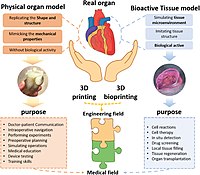
Photo from wikipedia
Extrusion bioprinting has been widely used to fabricate complicated and heterogeneous constructs for tissue engineering and regenerative medicine. Despite the remarkable progress acquired so far, the exploration of qualified bioinks… Click to show full abstract
Extrusion bioprinting has been widely used to fabricate complicated and heterogeneous constructs for tissue engineering and regenerative medicine. Despite the remarkable progress acquired so far, the exploration of qualified bioinks is still challenging, mainly due to the conflicting requirements on the printability/shape-fidelity and cell viability. Herein, a new strategy is proposed to formulate a dynamic cross-linked microgel assembly (DC-MA) bioink, which can achieve both high printability/shape-fidelity and high cell viability by strengthening intermicrogel interactions through dynamic covalent bonds while still maintaining the relatively low mechanical modulus of microgels. As a proof-of-concept, microgels are prepared by cross-linking hyaluronic acid modified with methacrylate and phenylboric acid groups (HAMA-PBA) and methacrylated gelatin (GelMA) via droplet-based microfluidics, followed by assembling into DC-MA bioink with a dynamic cross-linker (dopamine-modified hyaluronic acid, HA-DA). As a result, 2D and 3D constructs with high shape-fidelity can be printed without post-treatment, and the encapsulated L929 cells exhibit high cell viability after extrusion. Moreover, the addition of the dynamic cross-linker (HA-DA) also improves the microporosity, tissue-adhesion, and self-healing of the DC-MA bioink, which is very beneficial for tissue engineering and regenerative medicine applications including wound healing. We believe the present work sheds a new light on designing new bioinks for extrusion bioprinting.
Journal Title: ACS applied materials & interfaces
Year Published: 2022
Link to full text (if available)
Share on Social Media: Sign Up to like & get
recommendations!